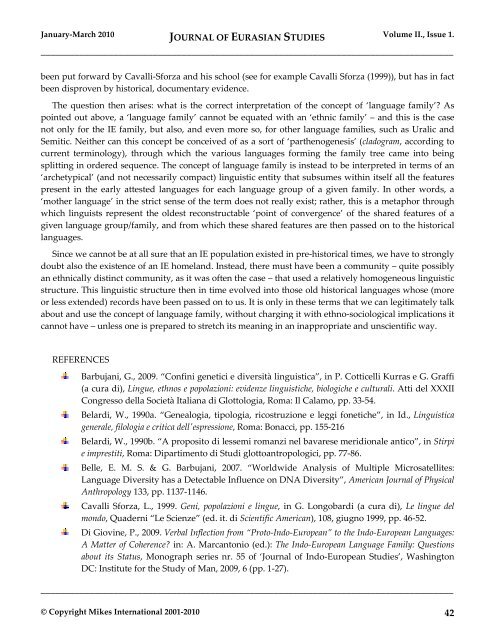EurasianStudies_0110..
EurasianStudies_0110..
EurasianStudies_0110..
Create successful ePaper yourself
Turn your PDF publications into a flip-book with our unique Google optimized e-Paper software.
January-March 2010 JOURNAL OF EURASIAN STUDIES Volume II., Issue 1.<br />
_____________________________________________________________________________________<br />
been put forward by Cavalli-Sforza and his school (see for example Cavalli Sforza (1999)), but has in fact<br />
been disproven by historical, documentary evidence.<br />
The question then arises: what is the correct interpretation of the concept of ‘language family’? As<br />
pointed out above, a ‘language family’ cannot be equated with an ‘ethnic family’ – and this is the case<br />
not only for the IE family, but also, and even more so, for other language families, such as Uralic and<br />
Semitic. Neither can this concept be conceived of as a sort of ‘parthenogenesis’ (cladogram, according to<br />
current terminology), through which the various languages forming the family tree came into being<br />
splitting in ordered sequence. The concept of language family is instead to be interpreted in terms of an<br />
‘archetypical’ (and not necessarily compact) linguistic entity that subsumes within itself all the features<br />
present in the early attested languages for each language group of a given family. In other words, a<br />
‘mother language’ in the strict sense of the term does not really exist; rather, this is a metaphor through<br />
which linguists represent the oldest reconstructable ‘point of convergence’ of the shared features of a<br />
given language group/family, and from which these shared features are then passed on to the historical<br />
languages.<br />
Since we cannot be at all sure that an IE population existed in pre-historical times, we have to strongly<br />
doubt also the existence of an IE homeland. Instead, there must have been a community – quite possibly<br />
an ethnically distinct community, as it was often the case – that used a relatively homogeneous linguistic<br />
structure. This linguistic structure then in time evolved into those old historical languages whose (more<br />
or less extended) records have been passed on to us. It is only in these terms that we can legitimately talk<br />
about and use the concept of language family, without charging it with ethno-sociological implications it<br />
cannot have – unless one is prepared to stretch its meaning in an inappropriate and unscientific way.<br />
REFERENCES<br />
Barbujani, G., 2009. “Confini genetici e diversità linguistica”, in P. Cotticelli Kurras e G. Graffi<br />
(a cura di), Lingue, ethnos e popolazioni: evidenze linguistiche, biologiche e culturali. Atti del XXXII<br />
Congresso della Società Italiana di Glottologia, Roma: Il Calamo, pp. 33-54.<br />
Belardi, W., 1990a. “Genealogia, tipologia, ricostruzione e leggi fonetiche”, in Id., Linguistica<br />
generale, filologia e critica dell'espressione, Roma: Bonacci, pp. 155-216<br />
Belardi, W., 1990b. “A proposito di lessemi romanzi nel bavarese meridionale antico”, in Stirpi<br />
e imprestiti, Roma: Dipartimento di Studi glottoantropologici, pp. 77-86.<br />
Belle, E. M. S. & G. Barbujani, 2007. “Worldwide Analysis of Multiple Microsatellites:<br />
Language Diversity has a Detectable Influence on DNA Diversity”, American Journal of Physical<br />
Anthropology 133, pp. 1137-1146.<br />
Cavalli Sforza, L., 1999. Geni, popolazioni e lingue, in G. Longobardi (a cura di), Le lingue del<br />
mondo, Quaderni “Le Scienze” (ed. it. di Scientific American), 108, giugno 1999, pp. 46-52.<br />
Di Giovine, P., 2009. Verbal Inflection from “Proto-Indo-European” to the Indo-European Languages:<br />
A Matter of Coherence? in: A. Marcantonio (ed.): The Indo-European Language Family: Questions<br />
about its Status, Monograph series nr. 55 of ‘Journal of Indo-European Studies’, Washington<br />
DC: Institute for the Study of Man, 2009, 6 (pp. 1-27).<br />
_____________________________________________________________________________________<br />
© Copyright Mikes International 2001-2010 42

















